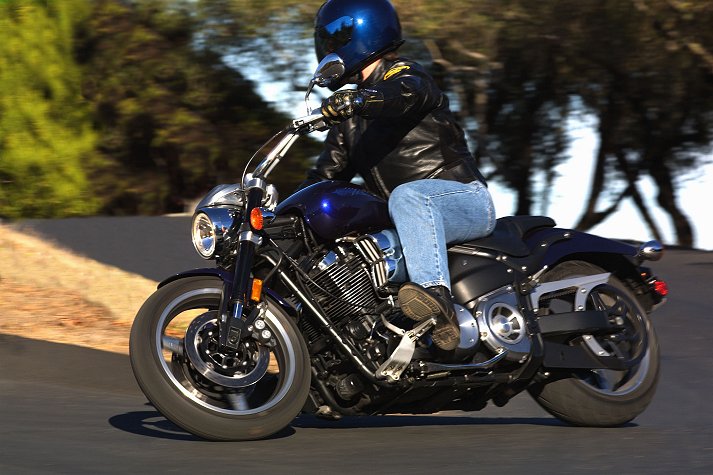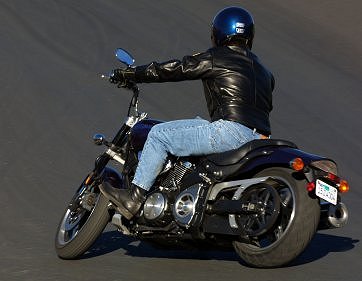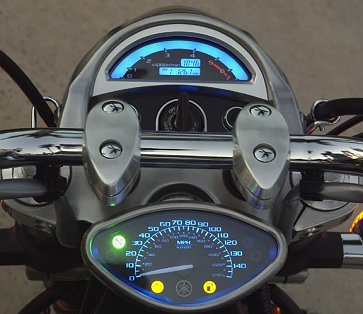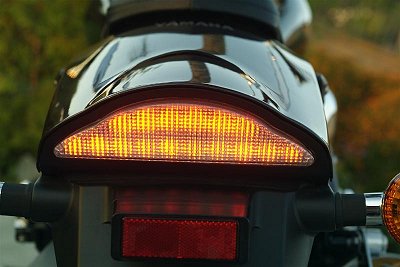
We provided Part One of this initial ride review last week, on October 25, 2001. These are additional thoughts on our first ride of the Warrior in the San Francisco Bay area early last week.

One thing I noticed about the Warrior is the different feel the aluminum chassis gives in different circumstances. Compared to the steel-framed cruisers I have ridden (including power cruisers like the Kawasaki Mean Streak and Honda VTX 1800), the Warrior feels a bit different and handles a bit different — presumably, due to the stiffer aluminum frame, which has a higher vibration frequency.
In the handling department, the bike changes directions much quicker than other cruisers I recall riding. Indeed, until you get used to it, the Warrior can almost seem a little bit nervous. This probably has to do with expecting the handling of a traditional cruiser, and experiencing something quite different. Once I was “calibrated” to the Warrior’s ride, this was not an issue and, in fact, straight line stability seemed quite good.
I mentioned in the initial article on October 25 that the bike sticks like glue in smooth corners. I did notice that corners with rough pavement caused the rear suspension to feel a bit unsettled — almost like the bike wanted to skip rather than track. The roads we were on were primarily smooth, so I didn’t have enough experience with this sensation to fully appreciate it. We hope to have a production Warrior for a more extended test a bit later, and suspension settings could be slightly different (our test bikes were pre-production). We will also play with tire pressure, if necessary, to try and dial out this sensation.
The Warrior has a very aggressive (for a cruiser) riding position. The bars lean the rider forward (a rarity for a cruiser), while the foot pegs are perhaps a bit less forward than most cruisers. This riding position contributes to a sense of control in the corners. Some riders may not like how forward the bars are, but this could be changed by swapping to another set of more traditional bars.

Like other large cruisers, low speed handling (i.e., parking lot speeds) takes getting used to. Again, towards the end of the ride, low speed handling felt more than adequate, probably due to the simple fact that I was getting used to riding the bike, and the “new” riding position.
The motor (and the exhaust note, as well) is really a pleasure to use and hear. That huge, somewhat controversial-looking exhaust muffler has been carefully tuned, according to Yamaha, for both maximum power output and sound quality.
The motor is really quite flexible and pulls well from very low revs. After riding the bike for 100 miles or so (through countless turns), I recall feeling only once that I was exiting a corner in the wrong gear. This was while I had a Yamaha test rider dogging me on a standard Road Star, with the floorboards grinding loud enough that I thought he was crashing in virtually every corner. By the way, while those floorboards were folding up and grinding on the standard Road Star, the Warrior rarely touched down, and then only the tip of the peg feeler (40 degree lean angle, remember?).

Yamaha was careful to design the Warrior to be easily customizable. This is part of the reason for the belt drive (allowing easier installation of after-market wheels, as well as stylized belt wheels).
As it does with its other Road Star bikes, Yamaha will support the Warrior with an extensive array of accessories and products. Even before its introduction, forty bolt-on accessories are ready for sale, and a competition engine and exhaust kit will be available . . . producing a claimed 100 rear wheel horsepower.
Lest you think the Warrior engine is simply a big-bore Road Star engine, you need to know that the Warrior engine has been extensively modified. The 102 cubic inch (1670 cc) engine not only has a larger bore than the Road Star, it has all new cylinder heads, cylinders, air intake system, fuel injection system, and, of course, exhaust system. A redesigned valve train permits higher RPM.
Using Yamaha’s figures, the Warrior makes 79.9 horsepower at 4,400 RPM and 103.8 pounds feet of torque at 3,500 RPM at the rear wheel on a Dynojet Model 200 dyno.
Complementing everything else are sportbike-derived suspension and brakes, and extremely light wheels (which contribute to the quick turning).
The Road Star Warrior will be on sale in the United States in early December with an MSRP of $11,999. From a handling perspective, it pretty clearly represents the most aggressive, and nimble, power cruiser yet. The Road Star faithful will be happy with the traditional sound and feel of the air-cooled motor, and Yamaha should easily get its fair share of the many riders expected to enter the power cruiser market.





